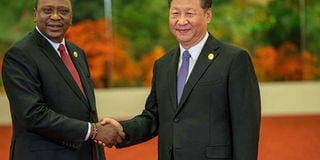The China factor in Africa: Partner or economic predator?

President Uhuru Kenyatta (left) meets his Chinese counterpart Xi Jinping at the opening session of the Forum for Africa-China Cooperation Summit in Beijing, China, on September 3, 2018. PHOTO | NATION MEDIA GROUP
What you need to know:
- During the FOCAC Summit, Chinese President Xi Jinping told his African colleagues his country would be pumping another Sh6 trillion in the continent.
- Zambia and Ethiopia are in discussion for the same but China is taking over Zambia’s power utility firm, Zesco, after Lusaka defaulted on $8.7 billion worth of Chinese loans.
The dust on the Focus on China-Africa Cooperation Summit held in Beijing earlier this month may have died down.
But the impact of decisions made there have elicited a rigorous debate on China’s role in the continent.
Gathered at a hall in Nairobi last week, experts in international trade, development policy and foreign aid and relations debated on whether financial aid from Beijing is trapping Africa or providing the route out of poverty.
During the FOCAC Summit, Chinese President Xi Jinping told his African colleagues his country would be pumping another Sh6 trillion in the continent.
It was in addition to a similar amount announced at a previous summit in 2015, doubling Beijing’s financial commitment to Sh12 trillion in just 36 months. This amount is twice what Japan, through their similar programme called Ticad, have sent to Africa since 2012.
The money would have ‘no political strings attached’, President Xi said.
DEBT
But that pledge created both support and criticism. Supporters view the pledge as China’s continued move to fill a vacuum: supporting the continent where Western development partners were either reducing or tightening conditions for help.
Opponents, on the other hand, saw this as a bid to tie down the continent into massive debt, trapping its inhabitants to be slaves to Beijing.
For example, the US National Defence Strategy for 2018 accuses Beijing of “predatory economic practices” targeting neighbours and other vulnerable countries.
Critics in Kenya amplified their view after it emerged Nairobi had not yet secured financing to build the Standard-Gauge Railway on to Kisumu and that the Chinese were now assessing feasibility first before committing.
LOANS
It also came amid stringent tax proposals like VAT on petroleum products, tax on airtime and mobile money transfers as well as cutting down on spending.
So what is the true picture? Africa is the biggest recipient of China’s Foreign aid, taking nearly 52 percent between 2000 and 2012, according to the China-Africa Research Initiative.
It will have loaned Africa Sh12 trillion by 2021, according to FOCAC. At Sh534 billion, Beijing is one of the major creditors to Kenya but not the biggest.
In Nairobi, the discussants at the forum organised by the Africa Policy Institute (API) debated whether China should be blamed for loaning Kenya or Africa.
Development Economist Anzetse Were told the audience Africa’s debt debate should first relook at governance issues.
“China is already playing its role (in providing financial aid); it is time for African governments to seize their decision-making power,” the Business Daily columnist argued.
She said that as long as ordinary folks in Africa are kept in the dark about the nature of financing deals their leaders enter into, it is Africa to blame not China when debt mounts.
INFRASTRUCTURE
Chinese officials say their foreign aid to Africa has seen construction of 6, 000km of railroad, 5,000km of highways.
Between 2000 and 2017, a study by the Africa Policy Institute found China extended $136 billion (Sh13.6 trillion) to African governments and their enterprises in the form of official development aid, export credit, suppliers’ credit and commercial credit.
API CEO Peter Kagwanja, who moderated the forum, argued Africa should see Chinese loans as some form of Marshall Plan, and use it in a way similar to the US post-World War II financial assistance to Europe, to ensure infrastructure we build is supported by policies to break trade barriers and ensure we borrow as much technology as possible from China.
Yet that mounting debt has caused problems back home. Angola, DRC, Ethiopia, Kenya and Sudan account for over half of Chinese lending in Africa.
Angola and Congo-Brazzaville have reviewed debt plans with China after it became difficult to repay routinely.
DEFAULTER
Zambia and Ethiopia are in discussion for the same but China is taking over Zambia’s power utility firm, Zesco, after Lusaka defaulted on $8.7 billion worth of Chinese loans.
Djibouti is facing similar predicament. Chinese Charge de Affairs Li Xuhang argued we should see a “bigger picture”, not just in terms of debt.
“The debt itself is not guilty. What matters is whether the debt is used for the country’s development, or for corruption or abused,” he argued.
According to latest figures from the Treasury, the World Bank is now the biggest creditor to Kenya at Sh581 billion and other countries like France, Japan, Belgium, UK, Netherlands, Finland and German all have fractions of bilateral debt with Kenya.
Mr David Owiro, a Trade Policy Consultant in the Ministry of Trade, argued the source of debt should be the least of worries, it should be how policies are developed to use the money.
“Regional policies need to be coherent so we can translate it into an African agenda,” he said.
The Chinese official added: “China's financing to Kenya and Africa is not a trap. African countries including Kenya, now in a period of rising development, are making efforts to realise industrialisation, economic diversification and modernisation... We have agreed to identify cooperation projects to help Africa overcome development bottlenecks.”





